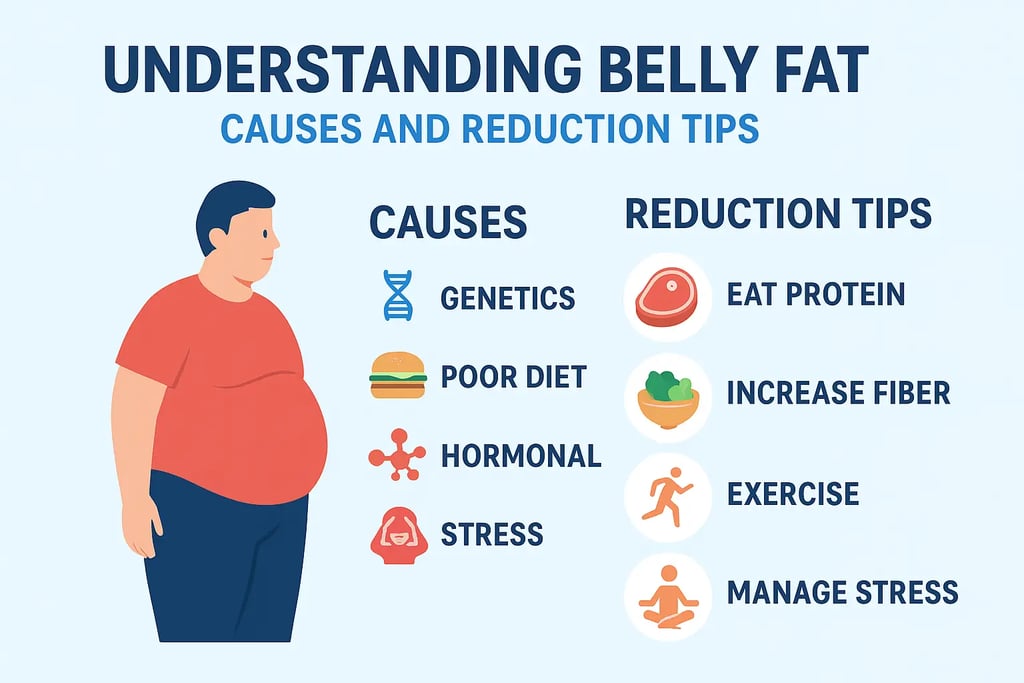Understanding Belly Fat: Causes, Health Risks, and How to Reduce It Fast
Learn what causes belly fat, its health risks, and the most effective diet, exercise, and lifestyle strategies to lose abdominal fat quickly and naturally.


Understanding Belly Fat: Causes, Risks, and Effective Reduction Strategies
What Is Belly Fat and Why Does It Accumulate in the Abdomen?
Belly fat, also known as abdominal fat, is one of the most common health concerns worldwide. Unlike general body fat, abdominal fat tends to accumulate around the midsection due to a combination of genetic, hormonal, dietary, and lifestyle factors. This fat can be particularly harmful because it surrounds vital organs and is linked to serious health conditions.
1. Genetic Factors Behind Belly Fat
Genetics play a significant role in determining where the body stores fat. People with a genetic predisposition for central obesity are more likely to develop excess fat around their abdomen, even when following similar diets and lifestyles as others. This inherited tendency can make it harder to lose belly fat despite consistent efforts.
2. Diet and Abdominal Fat Accumulation
A poor diet is one of the main causes of belly fat. Consuming refined sugars, processed foods, and high-calorie snacks leads to an increase in visceral fat—the fat stored deep within the abdomen.
When you eat high-sugar foods, your insulin levels spike, triggering fat storage. These insulin fluctuations cause hunger cravings, promoting overeating and encouraging fat buildup around the belly.
To prevent this, it’s crucial to adopt a diet rich in whole foods, lean proteins, and fiber while minimizing sugary and processed products.
3. Hormonal Imbalances and Belly Fat
Hormones such as cortisol (the stress hormone) and insulin greatly influence fat storage.
Cortisol: Chronic stress raises cortisol levels, increasing appetite and directing fat storage to the abdominal region.
Insulin: Poor diet and frequent sugar intake can lead to insulin resistance, making the body store more fat, especially in the belly.
Managing stress and stabilizing blood sugar levels are therefore essential to control hormonal belly fat.
4. The Impact of Stress on Abdominal Fat
Chronic stress not only triggers hormonal changes but also influences behavior. Many individuals under stress turn to comfort foods that are high in sugar and fat, worsening weight gain. Moreover, stress-related cortisol spikes further encourage central fat storage, making belly fat particularly stubborn to lose.
5. Why Belly Fat Is More Dangerous Than Other Fat
Not all body fat is the same. Visceral fat, the fat stored deep inside the abdomen, is metabolically active and linked to several health risks, including:
Type 2 diabetes
Metabolic syndrome
This makes understanding and reducing belly fat vital for long-term health and wellbeing.
How to Reduce Belly Fat Fast: Effective Diet Changes
1. Focus on High-Protein Foods
A protein-rich diet boosts metabolism, preserves lean muscle, and enhances fat burning. Include foods such as:
Lean meats, fish, eggs
Low-fat dairy products
Beans and legumes
Protein also helps control appetite, preventing overeating and late-night snacking.
2. Increase Fiber Intake
Soluble fiber aids digestion and helps you feel full for longer. Add these to your meals:
Fruits and vegetables
Whole grains
Lentils and chickpeas
Fiber regulates blood sugar levels and prevents fat accumulation around the abdomen.
3. Add Healthy Fats to Your Meals
Not all fats are bad. Healthy fats found in:
Nuts and seeds
Olive oil and fatty fish
These support heart health, reduce inflammation, and control hunger, making it easier to maintain a calorie deficit.
4. Avoid Sugar and Processed Foods
Eliminate refined sugars, soda, and junk food from your diet. Replace sugary beverages with water, green tea, or black coffee. These alternatives help cut empty calories and improve fat metabolism.
5. Eat in a Calorie Deficit — But Stay Nourished
To lose belly fat, you must burn more calories than you consume. However, ensure your diet remains nutrient-dense to support overall health. Plan balanced meals that meet your macronutrient and micronutrient needs.
6. Meal Timing Matters
Eating smaller, frequent meals helps regulate blood sugar and prevents overeating. Incorporate metabolism-boosting foods like green tea, chili peppers, and ginger into your daily diet.
Sample daily meal plan:
Breakfast: Oatmeal with berries and nuts
Lunch: Grilled chicken salad with avocado
Dinner: Steamed vegetables with baked fish
Snacks: Greek yogurt or apple slices with almond butter
Exercise and Lifestyle Tips to Burn Belly Fat Quickly
1. Try High-Intensity Interval Training (HIIT)
HIIT workouts combine short bursts of intense exercise with rest periods, making them one of the best methods to burn fat fast. These workouts enhance metabolism even after you finish exercising.
2. Focus on Core Strengthening Exercises
Incorporate exercises like:
These help tone the abdominal muscles while improving core stability.
3. Add Cardio to Your Routine
Aerobic exercises such as walking, jogging, swimming, or cycling are excellent for burning calories and reducing belly fat. Aim for at least 150 minutes of moderate activity per week.
4. Get Enough Sleep
Sleep deprivation affects hormones related to hunger and stress, leading to overeating and fat gain. Ensure 7–9 hours of quality sleep each night to support weight management.
5. Manage Stress Effectively
Try yoga, meditation, deep breathing, or journaling to reduce stress and lower cortisol levels. Stress management is key to preventing abdominal fat accumulation.
6. Stay Hydrated
Drink at least 8–10 glasses of water daily. Proper hydration supports metabolism, digestion, and detoxification—all crucial for losing belly fat.
7. Follow a Weekly Fitness Plan
Here’s a simple weekly belly-fat reduction plan:
Monday, Wednesday, Friday: HIIT workouts
Tuesday, Thursday: Core and strength training
Saturday, Sunday: Cardio activities (running, cycling, or brisk walking)
Final Thoughts: A Sustainable Approach to Belly Fat Loss
Losing belly fat quickly requires a balanced combination of diet, exercise, and lifestyle changes. Focus on high-protein, high-fiber meals, maintain regular physical activity, manage stress, and prioritize sleep.
While visible results may vary, consistency and discipline will help you achieve lasting fat loss and improved overall health.
